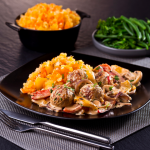
The WST Plan is based on low density foods which keep you feeling fuller for longer. An important tool in weight loss and healthy eating is Satiety.
Satiety is that wonderfully pleasant feeling of fullness you get as you eat, when you’re no longer hungry, but aren’t overly stuffed or uncomfortable. You are just satisfied beyond desire. The more satisfied you feel after a meal, the less you’ll eat later. So how do you increase satiety without eating MORE?
Just drinking a glass of water along with the meal does not provide the same degree of satiety. Research has shown that to reduce hunger and boost fullness, the water has to be in the food. Why? Because there are separate mechanisms in the brain to control hunger and thirst. If the food you eat contains the water, it will stay in the stomach longer while the food is being digested. Beyond that, there is also the psychological component of eating food versus drinking water. When you eat food, even water-rich food, you get more sensory stimulation because you have more food going through your mouth and you’re eating for a longer period of time, both of which help you feel more satisfied with your meal.
The following are all water-rich food choices with about 90% bound water. They can have a great impact on the calorie density of your diet.
- EAT MORE broth-based soups like chicken broth and vegetable broth.
- EAT MORE leafy greens like lettuce, baby spinach and mixed salad greens with fat-free dressing.
- EAT MORE fruits like apples, blueberries, cantaloupe, grapefruit, oranges, peaches, strawberries and watermelon.
- EAT MORE non-starchy vegetables like asparagus, broccoli, carrots, cauliflower, celery, cucumbers, tomatoes and winter squash.
- TIP: Start your meal with a bowl of broth-based soup or low-calorie leafy green salad to fill up on fewer calories. Turn to non-starchy vegetables when you get the munchies. (Becky Hand, 2013)
Lean on Protein
Studies suggest that protein appears to help prolong satiety more than carbohydrates or fat can.
- EAT MORE lean protein from meats, chicken, seafood, low-fat dairy, legumes, lentils and soy products.
- TIP: Prepare your meat using low-fat cooking methods like grilling and baking.
Fit in the Fat
Cutting fat intake reduces the calorie density of a food. In other words, you get a bigger portion of food for the same calories when it has fewer fat grams. However, if you go too low in fat you won’t enjoy the flavor, texture or satiety of your food. Plus dietary fat is essential for staying healthy.
- EAT ENOUGH fat. This will bring the pleasure and satisfaction back to your meals so you’re less likely to overeat later.
- TIP: Eliminate fat where you don’t need it, opting for reduced fat foods instead of full fat versions. Select low-fat dairy products, low-fat salad dressings, low-fat mayonnaise, etc. and limit saturated and trans fats. (Becky Hand, 2013)
Sonya. X
